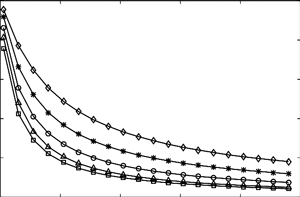Research of queuing model based on request queue in P2P network system
DOI:
https://doi.org/10.3103/S0735272721040026Keywords:
hybrid P2P network, node, queue, social optimal strategyAbstract
With the rapid growth of P2P network, the resource searching and resource delivery are two crucial problems required to be solved in a P2P system. At the resource searching stage, a large number of random resource requests form a search request queue at the node. At the resource delivery stage, if the nodes cannot process new requests at a certain time, the queue of resource requests may be congested at the node. The behavior of each user making a search request is a random phenomenon, so it is necessary to use the knowledge of queuing theory to allocate the users who request different resources and manage these request queues to provide services efficiently, which are based on the hybrid P2P network model in this paper. Firstly, a two-dimensional Markov chain is constructed, and the steady state distribution of system is determined by using the method of matrix geometric solution. Secondly, the expressions of performance indexes, such as the probability that the local Peer Node (PN), the remote PN and Virtual Content Server (VCS) provide the users, are obtained, and the influence of different system parameters on the performance indexes are analyzed using the results of numerical calculations. Finally, in order to avoid congestion of the request queue, the social benefit function is defined, and the optimal user arrival rate of system is obtained.
References
- W.-W. Shen, S. Su, K. Shuang, F.-C. Yang, “SKIP: An efficient search mechanism in unstructured P2P networks,” J. China Univ. Posts Telecommun., vol. 17, no. 5, pp. 64–71, 2010, doi: https://doi.org/10.1016/S1005-8885(09)60509-4.
- A. Ferragut, F. Paganini, “Queueing analysis of peer-to-peer swarms: Stationary distributions and their scaling limits,” Perform. Eval., vol. 93, pp. 47–62, 2015, doi: https://doi.org/10.1016/j.peva.2015.08.003.
- X. Meng, S. Ren, “An outlier mining-based malicious node detection model for hybrid P2P networks,” Comput. Networks, vol. 108, pp. 29–39, 2016, doi: https://doi.org/10.1016/j.comnet.2016.07.008.
- S. K. Awasthi, Y. N. Singh, “Simplified Biased Contribution Index (SBCI): A mechanism to make P2P network fair and efficient for resource sharing,” J. Parallel Distrib. Comput., vol. 124, pp. 106–118, 2019, doi: https://doi.org/10.1016/j.jpdc.2018.10.002.
- S. Sun, W. Yao, B. Qiao, M. Zong, X. He, X. Li, “RRSD: A file replication method for ensuring data reliability and reducing storage consumption in a dynamic Cloud-P2P environment,” Futur. Gener. Comput. Syst., vol. 100, pp. 844–858, 2019, doi: https://doi.org/10.1016/j.future.2019.05.054.
- G. Li, Study on Searching Technology in Hybrid P2P Network. Chongqing: Chongqing University, 2017.
- X. Liu, Study of Request Queue in P2P Networks System Based on the Queuing Theory. Xi’an: Xidian University, 2017.
- J.-G. Wu, N. Jiang, Z.-Q. Zou, B. Hu, L. Huang, J.-L. Feng, “HPSIN: A new hybrid P2P spatial indexing network,” J. China Univ. Posts Telecommun., vol. 17, no. 3, pp. 66–72, 2010, doi: https://doi.org/10.1016/S1005-8885(09)60468-4.
- C. Hammami, I. Jemili, A. Gazdar, A. Belghith, M. Mosbah, “Hybrid live P2P streaming protocol,” in Procedia Computer Science, 2014, vol. 32, pp. 158–165, doi: https://doi.org/10.1016/j.procs.2014.05.410.
- M. A. Rongfei, “Super node selection algorithm combining reputation and capability model in P2P streaming media network,” Pers. Ubiquitous Comput., vol. 23, no. 3–4, pp. 435–442, 2019, doi: https://doi.org/10.1007/s00779-019-01219-y.
- H. Ayatollahi, M. Khansari, H. R. Rabiee, “A push-pull network coding protocol for live peer-to-peer streaming,” Comput. Networks, vol. 130, pp. 145–155, 2018, doi: https://doi.org/10.1016/j.comnet.2017.11.007.
- G. P. Basharin, Y. V. Gaidamaka, K. E. Samouylov, “Mathematical theory of teletraffic and its application to the analysis of multiservice communication of next generation networks,” Autom. Control Comput. Sci., vol. 47, no. 2, pp. 62–69, 2013, doi: https://doi.org/10.3103/S0146411613020028.
- X.-J. Shen et al., “Achieving dynamic load balancing through mobile agents in small world P2P networks,” Comput. Networks, vol. 75, no. PartA, pp. 134–148, 2014, doi: https://doi.org/10.1016/j.comnet.2014.05.003.
- H.-L. Liu, G.-X. Chen, Y. Chen, Q.-B. Chen, “A trust-based P2P resource search method integrating with Q-learning for future Internet,” Peer-to-Peer Netw. Appl., vol. 8, no. 3, pp. 532–542, 2015, doi: https://doi.org/10.1007/s12083-014-0279-x.
- V. K. Marigodov, “Spaced radio receive as a queueing system with mixed priorities,” Radioelectron. Commun. Syst., vol. 53, no. 1, pp. 52–55, 2010, doi: https://doi.org/10.3103/S0735272710010097.
- T.-Q. He, L.-J. Cai, Z.-Y. Deng, T. Meng, X. Wang, “Queuing-oriented job optimizing scheduling in cloud mapreduce,” in Proc. of International Conference on P2P, Parallel, Grid, Cloud and Internet Computing, 2017, pp. 435–446, doi: https://doi.org/10.1007/978-3-319-49109-7_41.
- I. V. Strelkovskaya, T. I. Grygoryeva, I. N. Solovskaya, “Self-similar traffic in G/M/1 queue defined by the Weibull distribution,” Radioelectron. Commun. Syst., vol. 61, no. 3, pp. 128–134, 2018, doi: https://doi.org/10.3103/S0735272718030056.
- S. Jin, S. Hao, X. Qie, W. Yue, “A virtual machine scheduling strategy with a speed switch and a multi-sleep mode in cloud data centers,” J. Syst. Sci. Syst. Eng., vol. 28, no. 2, pp. 194–210, 2019, doi: https://doi.org/10.1007/s11518-018-5401-9.
- G. Zhao, S. Jin, C. Ma, J. Cao, L. Xu, “Analysis on cloud service system with variable number of servers,” J. Beijing Univ. Posts Telecommun., vol. 42, no. 4, pp. 114–120, 2019, doi: https://doi.org/10.13190/j.jbupt.2018-297.
- M. R. Neuts, Matrix-geometric Solutions in Stochastic Models: An Algorithmic Approach. Baltimore: The Johns Hopkins University Press, 1981.


